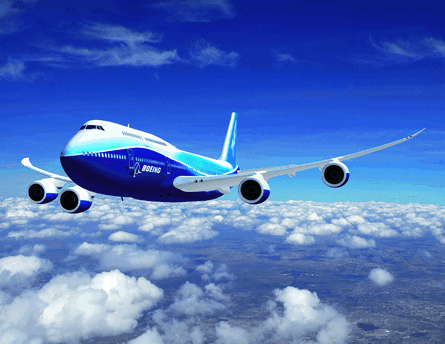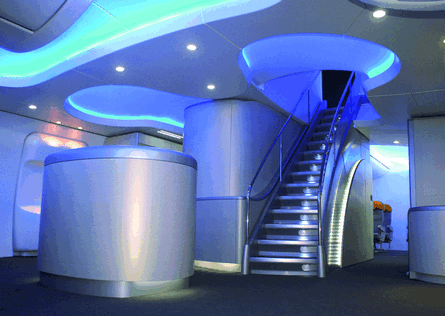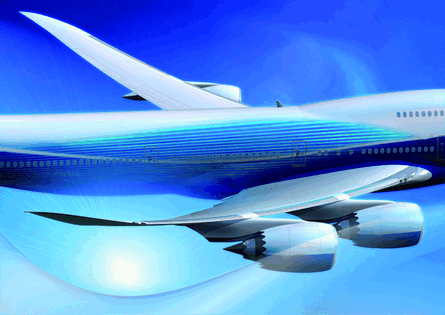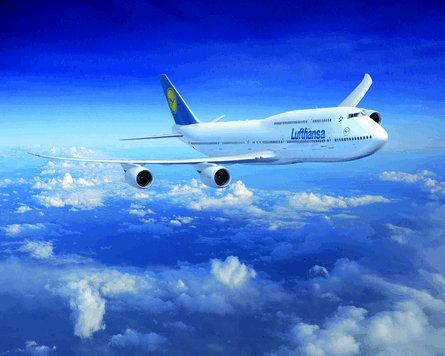Approaching its fourth decade in service, the 747 has grown to carry 467 passengers in three classes
In its more than 40-year history, the Boeing 747 has been able to grow and adapt to virtually every market condition, surviving and thriving in the expansions and contractions of an industry known for its powerful peaks and often painful valleys. The jumbo jet's potential to grow over the years has been the key to its success with more than 1,500 aircraft ordered since Juan Trippe and Pan American Airways launched the aircraft in 1966.
The basic configuration of the 747 has served Boeing extremely well during its first 42 years of service. Without increasing the length or cross section of the 70.6m (232ft)-long aircraft, Boeing was able to increase the three-class passenger capacity by 50 seats and its two-class capacity by 72 seats from its original design over the years.
 |
|---|
© Boeing |
Range Pushed
The 747-400, which was launched in 1985 and first delivered in 1989 pushed the 747's range to 13,450km (7,260nm) with a redesigned wing and a choice of three new engine types from Rolls-Royce, General Electric and Pratt & Whitney. The 747-400 family eventually grew to six different variants, two cargo and four passenger aircraft for different missions.
Over its life, the maximum take-off weight of the aircraft has been increased 24% from Boeing's original Spirit of Everett 747-100 to the 747-400ER to 415,000kg (910,000lb).
When Airbus began offering the A380 in 2001, orders for Boeing's largest offering slowed considerably. The final passenger 747-400 was ordered in November 2002 by Taiwan's China Airlines and delivered in April 2005. Even before the final order for the 747-400 family was received in 2006 for two 747-400ERFs for LoadAir Cargo, Boeing launched its fifth-generation 747.
The two variants, designated the 747-8 intercontinental and freighter, have received 105 orders to date. Seventy-eight of those are for the 747-8 freighters and the remainder are for the passenger intercontinental variant, divided between 20 for Lufthansa, the only airline customer for the type, and seven custom- configured Boeing 747 Business Jets.
The 747-8 is 5.6m longer than its predecessor the 747-400 and represents the first stretch of the 747 fuselage since the aircraft was launched. Boeing has found significant success with the 747-8 freighter, which promises a fully loaded range of 8,185km and 16% lower tonne-kilometre costs.
 |
|---|
© Boeing |
This success, in part, was due to Airbus's struggle to get A380 production up and running. Airbus was forced to divert engineering attention away from development of the freighter variant. As a result, the four previous A380F customers Emirates Skycargo, FedEx, International Lease Finance and UPS have cancelled their 27 orders.
Even Airbus chief salesman John Leahy, who has conceded 100% of the largest cargo aircraft market share to Boeing, says that the 747-8 makes an "acceptable" freighter, perhaps the highest of compliments coming from Boeing's chief competitor.
Struggle
Boeing's three-class 467-seat 747-8I aircraft has struggled to gain its footing in the market, even with performance expectations of an 14,815km range and 16% improvement in fuel burn on a per-passenger basis over the 747-400 and 11% better than the A380 per passenger.
 |
|---|
© Boeing |
Boeing lost one of its key sales battles last year when British Airways selected the A380 and 787 Dreamliner for its long-range fleet, shunning the new 747 design.
The closest Boeing has come to booking an order for the 747-8I since Lufthansa announced its launch of the type in December 2006 was a public announcement of the signing of a letter of intent by Nigeria's fledgling Arik Air for three aircraft in May of this year.
Through the first half of 2008, Airbus and Boeing have shared the struggle to sell their largest aircraft. Both airframers have sold just five aircraft in this category since January. Airbus sold three A380-800s to Korean Airlines and Boeing two 747-8 intercontinental aircraft to private operators.
Orders for the largest passenger offerings from both Airbus and Boeing in 2008 illustrate the challenges of selling aircraft on the downside of the cycle.
To date, Airbus has garnered 192 orders for the A380 to Boeing's 105 for the 747-8.
Yet today, every calculation in commercial air transport begins and ends with the cost of oil. Overall market receptiveness to large passenger aircraft has been tepid as of late, somewhat attributable to an unchangeable fact that four engines burning fuel is less attractive compared with an aircraft with half as many. With airlines trending towards cutting capacity and long range point-to-point routing, the twin-engined A350 XWB and longer-range 777s have been the beneficiaries.
The high cost of oil has inflicted significant damage on the industry already with falling profits making large aircraft orders increasingly difficult for both Airbus and Boeing.
Customer Outlook
Even so, Richard Aboulafia, vice-president of analysis for the Teal Group, has identified four Asian airlines that could be potential customers for the 747-8. Japan's All Nippon Airways and Japan Airlines, Hong Kong based Cathay Pacific Airways and South Korea's Asiana Airlines are all seen as customers weighing an A380/747-8 order.
All have been reliable 747 customers and, according to Flight's ACAS database, represent a combined total of 62 747-400s, about 14% of the total -400s delivered by Boeing during its production run.
Of the four airlines, Asiana appears closest to a decision on a widebody aircraft order, which according to sources, is expected to be announced at the Farnborough air show. Though that order is likely to address A350 and/or 787 purchases, not large aircraft which is more likely to come in the second half of the year.
ANA, JAL and Cathay Pacific are all operators of Boeing's hot-selling 365-seat 777-300ER that are being used to replace older 747-400 aircraft.
ANA is a prime target for Airbus to break into the largely unreceptive Japanese market. Following delays in the 787 Dreamliner programme and the schedule uncertainty for the 787-3 short-range variant, Airbus believes it could have leverage with the airline to offer the A380 as a 747-400 replacement to grow capacity. The airline has said it plans to retire its 747-400 fleet by 2012, leaving the 777-300ER as the largest aircraft in its fleet. ANA had initially indicated it did not see a role for the A380 in its fleet, but is likely to consider the ultra-large aircraft in its planning.
Leahy said in February that "we have not received ANA's request for proposals yet, but when we do, we will be offering the A380".
For JAL, the world's largest 747 operator, purchase of the 747-8 could present advantages over the A380. For example, ease of crew transitioning between older and newer 747 models and potential technical commonality between the General Electric GEnx-1B64 engines selected for its 787 Dreamliners and the GEnx-2B67 engines offered on the 747-8.
Cathay Pacific, which has a fleet of 24 747-400s and is leaning heavily on newly delivered 777-300ERs, has said the airline is in no hurry to make a decision on the A380 or 747-8I.
 |
|---|
General manager purchasing and aircraft trading for Cathay Pacific Greg Hughes said in August 2007 that "we will continue to evaluate larger aircraft such as the A380 and 748 Intercontinental, but as we have a large fleet of Boeing 747-400s, which will be with us for some years, we feel no need to make a decision on the large aircraft at this time."
Cathay Pacific has already ordered 10 747-8 freighters. In addition, the airline recently issued a profit warning cautioning that financial results would be "materially and adversely affected by the high price of jet fuel, with the average price paid by Cathay Pacific in the first half of 2008 60% above that paid in the first half of 2007".
A Shrewd Move
Boeing's launch of the 747-8 programme presented a strategic opportunity for the air framer to get maximum return on a modest investment. Development costs for the derivative aircraft have been estimated at around $1 billion, a small sum compared with the estimated $18 billion invested by Airbus to develop the A380.
With a backlog of 105 orders for the 747-8 programme, it is likely that Boeing has recouped its initial investment even if it offered significant discounts to customers. The list prices for the 747-8 range from $285 million to $300 million depending on the passenger or freighter variant.
For Airbus, which has historically been reliant on cashflow rather than overall profitability, the loss of each A380 order to passenger and freighter 747-8s means an unrealised revenue opportunity that could be as high as $337.5 million for each aircraft.
In the late 1960s, as design work for the original 747 was rolling along, the programme struggled for engineering resources that were devoted to its flagship programme at the time, the supersonic transport Boeing 2707.
The government-funded 2707 held Boeing's focus pulling key engineering resources away from the company's other new programme at the time, the 747.
The SST's budget was eventually cut by the US Congress in 1971 after the 747-100 had already entered revenue service with Pan American Airways. With its roll-out expected almost exactly 40 years to the day since its trailblazing predecessor took to the skies, the 747-8 is facing a similar battle for engineering resources with the company's flagship 787 Dreamliner programme.
Assembly for the first 747-8 is set to begin in August and Boeing expects to have 90% of the engineering designs released by then in time to begin full final assembly operations in the early part of 2009.
As the 787 programme finds its footing, previously diverted 747-8 engineers are "trickling in" again, says one senior 747 programme engineer.
Fever Pitch
Engineering work is continuing at a fever pitch and some staff are working significant overtime to ensure that the February roll-out and beginning of the flight-test programme does not slip.
Because of the diversion of engineering resources to assist in the recovery of the 787 programme, Boeing revamped its assembly schedule for the 747-8F, the first of the two new 747 variants to be flown and certified.
Boeing pushed the roll-out from November 2008 to February 2009. As a result, Boeing will be able to deliver all the remaining 747-400 family aircraft and transition its assembly line to a more lean set up to accommodate the two new larger 747s.
Although the 747-8 flight-test programme has been compressed by two to three months, the delivery date for the freighter has not changed and is still targeted for the third quarter of 2009 to Cargolux.
Although the passenger variant of the 747-8 may not be the sales success Boeing would hope, a senior programme engineer says that this fact is no concern for those working to design the aircraft. He says there has been no let- up: "We have a commitment to customers."
Source: Flight International
















